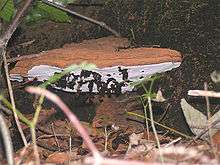Ganoderma applanatum
| Ganoderma applanatum | |
|---|---|
 | |
| Scientific classification | |
| Kingdom: | Fungi |
| Division: | Basidiomycota |
| Class: | Agaricomycetes |
| Order: | Polyporales |
| Family: | Ganodermataceae |
| Genus: | Ganoderma |
| Species: | G. applanatum |
| Binomial name | |
| Ganoderma applanatum (Pers.) Pat. | |
| Synonyms | |
| |
Ganoderma applanatum (the artist's bracket, artist's conk[1] or bear bread) is a bracket fungus with a cosmopolitan distribution.
This fungus grows as a mycelium within the wood of living and dead trees. It forms fruiting bodies that are up to 30–60 centimetres (12–24 in) across, hard, woody-textured, and inedible; they are white at first but soon turn dark red-brown. Brown spores are released from the pores on the underside of the fruiting body. The fruiting bodies are perennial, and may persist for multiple years, increasing in size and forming new layers of pores as they grow.
It is a wood-decay fungus, causing a rot of heartwood in a variety of trees. It can also grow as a pathogen of live sapwood, particularly on older trees. It is a common cause of decay and death of beech and poplar, and less often of several other tree genera, including alder, apple, elm, buckeye and horse chestnut, maple, oak, walnut, willow, western hemlock, Douglas Fir, and Spruce.
A peculiarity of this fungus lies in its use as a drawing medium for artists. When the fresh white pore surface is rubbed or scratched with a sharp implement, dark brown tissue under the pores is revealed, resulting in visible lines and shading that become permanent once the fungus is dried.
The Anne Frank tree in Amsterdam suffered rot from Ganoderma applanatum before it blew over in 2010.
Medicinal Uses
Ganoderma applanatum is known in Japan as kofuki-saru-no-koshikake (コフキサルノコシカケ),[2][3] literally meaning "powder-covered monkey's bench", and in China as shu-she-ling-zhi (树舌灵芝), where it has long been used in traditional medicines.[4] Studies have shown Ganoderma applanatum contains compounds with potent anti-tumor,[5][6][7] antibacterial[8][9] anti-fibrotic[10] properties.
Fungivory
There is anecdotal references of higher primates consuming this fungus for self-medication.[11]
In the book Gorillas In the Mist Dian Fossey writes the following about gorillas eating Ganoderma applanatum:
"Still another special food (for the gorillas) is bracket fungus (Ganoderma applanatum)... The shelflike projection is difficult to break free, so younger animals often have to wrap their arms and legs awkwardly around a trunk and content themselves by only gnawing at the delicacy. Older animals who succeed in breaking the fungus loose have been observed carrying it several hundred feet from its source, all the while guarding it possessively from more dominant individuals attempts to take it away. Both the scarcity of the fungus and the gorillas' liking of it cause many intragroup squabbles, a number of which are settled by the silverback, who simply takes the item of contention for himself."[12]

The midge Agathomyia wankowiczii (Platypezidae) lays its eggs on the fruiting body of the fungus, forming galls.[13] The forked fungus beetle, Bolitotherus cornutus lives out its entire life cycle in the fruiting bodies of Ganoderma applanatum and a few other bracket fungi.[14]
| Ganoderma applanatum | |
|---|---|
|
| |
| pores on hymenium | |
| no distinct cap | |
| hymenium is decurrent | |
| lacks a stipe | |
| spore print is brown | |
| ecology is parasitic | |
| edibility: inedible | |
See also
References
- ↑ Overson, Alissa. "Ganoderma applanatum: The Artist's Conk". The Fungal Kingdom. Evergreen State College. Retrieved 3 March 2016.
- ↑ "kofuki- saru-no-koshikake (コフキサルノコシカケ)". Flora of Mikawa. Retrieved 3 March 2016.
- ↑ Mizuno, Takashi. "Sarunokoshikake: Polyporaecea fungi‐kofukisarunokoshikake, ganoderma applanatum and tsugasarunokoshikake, fomitopsis pinicola". Taylor & Francis Online.
- ↑ "About Asian Anti-Cancer Materia Database". http://asiancancerherb.info/. External link in
|website=(help) - ↑ MIZUNO, TAKASHI; et al. "Isolation and characterization of antitumor active β-d-glucans from the fruit bodies of Ganoderma applanatum". Elsevier Science Publishers B.V., Amsterdam - Printed in The Netherlands. Retrieved 3 March 2016.
- ↑ Taichi Usui et. al. "Antitumor Activity of Water-Soluble β-D-Glucan Elaborated by Ganoderma applanatum". Taylor & Francis Online. Retrieved 5 March 2016.
- ↑ "Applanoxidic acids A, B, C and D, biologically active tetracyclic triterpenes from Ganoderma applanatum". Phytochemistry. 30 (12, 1991): 4105–4109. 26 March 1991. doi:10.1016/0031-9422(91)83476-2.
- ↑ "Antibacterial Activity of Steroidal Compounds Isolated from Ganoderma applanatum". International Journal of Medicinal Mushrooms. 1, 1999 Issue 4: 325–330. doi:10.1615/IntJMedMushr.v1.i4.40.
- ↑ "Exopolysaccharide from Ganoderma applanatum as a Promising Bioactive Compound with Cytostatic and Antibacterial Properties". BioMed Research International. 2014: 1–10. July 2014. doi:10.1155/2014/743812.
- ↑ Luo, Q; Di, L; Dai, WF; Lu, Q; Yan, YM; Yang, ZL; Li, RT; Cheng, YX (February 23, 2015). "Applanatumin A, a new dimeric meroterpenoid from Ganoderma applanatum that displays potent antifibrotic activity". Org. Lett. 17: 1110–3. PMID 25706347. doi:10.1021/ol503610b.
- ↑ "MEDICINAL PROPERTIES IN THE DIET OF GORILLAS" (PDF). African Study Monographs. 23 (2): 71. June 2002. doi:10.14989/68214.
- ↑ Fossey, Dian (1983). Gorillas in the Mist. Mariner Books. p. 52. ISBN 9780395282175.
- ↑ Brian Spooner; Peter Roberts (1 April 2005). Fungi. Collins. p. 126. ISBN 978-0-00-220152-0. Retrieved 31 January 2012.
- ↑ Liles, M.P. (1956). "A study of the life history of the forked fungus beetle, Bolitotherus cornutus" (PDF). Ohio J Sci. 56: 329–337.
- Phillips, D. H., & Burdekin, D. A. (1992). Diseases of Forest and Ornamental Trees. Macmillan.
- Ganoderma applanatum
- Ganoderma applanatum
- Photographs of the fungus, including one used as a drawing surface
- Several drawings created on these fungi
External links
 Media related to Ganoderma applanatum at Wikimedia Commons
Media related to Ganoderma applanatum at Wikimedia Commons- Observations on Mushroom Observer